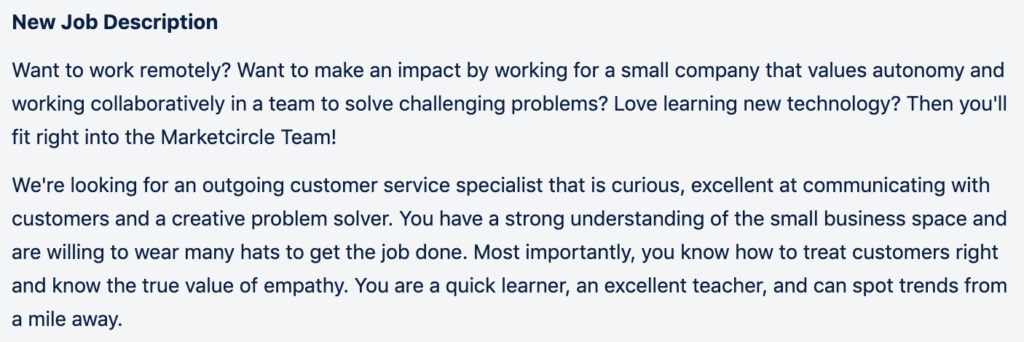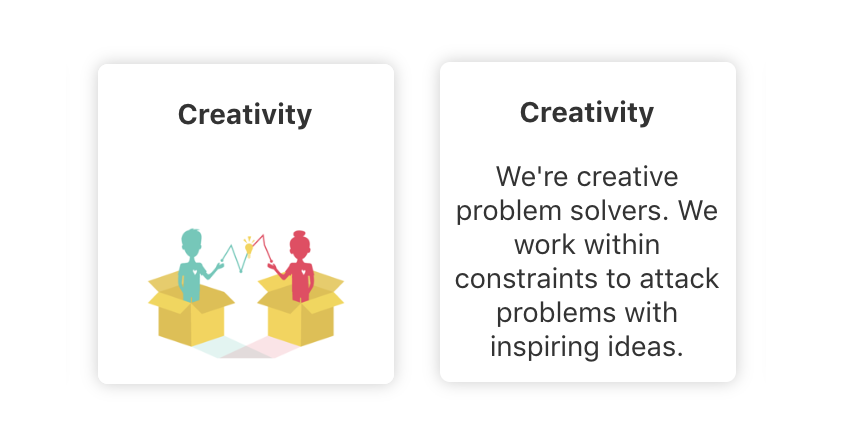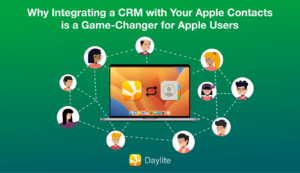When your small business starts to take off, you’re soon faced with needing to hire one or even several employees. It’s an exciting time, but recruiting is no easy task. Like most small businesses, we, too, have struggled with the process of building our team.

Not getting a handle on your hiring as early as possible creates problems you will unavoidably have to deal with in the future. Eventually, this will distract from your goals, from closing more deals to scaling your business. Over time, we’ve used Kaizen to improve our talent acquisition, and below, we’re sharing the details of our challenges and how we are working on overcoming them.
Our challenges with recruiting
As we’ve grown from 1 to 50 employees over the years, we’ve struggled to fill roles, hired the wrong people, and learned that the recruitment process doesn’t just end when you’ve found the right candidate. The most common challenges we and most small business face are:
- Finding and attracting the right candidates
- Interviewing effectively
- Onboarding new employees
- Hiring the right person
How we fixed it
We took a hard look at our recruitment practices and evaluated the below stages to not only streamline our process but also ensure that we were finding the best talent to scale our business and embody the culture of our company. It’s always a work in progress, but taking these fairly simple steps has already made a big improvement!
Candidates and time to hire
If you can’t find and attract the right kind of talent, to begin with, you’re starting off the already difficult task of hiring at a massive disadvantage. You’re competing with several other companies, many of which have more resources than you do to throw into their recruitment. We encountered this problem when we realized we weren’t doing enough to sell our company in our job description and job postings.
To solve this, we:
Revamped our job descriptions. Our previous job descriptions were fairly standard, outlining the job responsibilities, experience required, and hypothetical scenarios we wanted the candidate to react to. We spent less time explaining Marketcircle and who were are and used a lot of buzzwords to try and describe our environment.
You can see this in the below excerpt of our old job description:

In our new job descriptions, to change this, we first focused on what it’s like to work at Marketcircle, our perks, culture, and mission. As you can see below, we still capture the job responsibilities but also include how we measure success, what kind of methodologies shape our culture and the kind of impact an employee can expect to make with us. Now we are confident in the description that is forming our potential candidate’s first impression of Marketcircle and impacting whether or not they will apply.

Additional changes we made:
- Revamped our About Us page to make it more about selling our company and what it’s like to be a part of Marketcircle, rather than focusing on our products. We clearly defined our core values, our mission statement, and highlighted that there is a real team of people behind the company name with candid photos (no stuffy portraits!) and blurbs showing our personalities.
- Revamped our Careers page to once again highlight our mission statement and provide potential candidates with an accurate representation of what it’s like to work for us. We wanted to make sure we laid out the unique perks of our company, and also allowed the candidate to understand the kind of impact they could have if they joined us, a small business. To encourage transparency, we also explained our hiring process which is often a mystery many people face when applying for jobs. We included our Instagram so candidates were invited to get a deeper look into who we are and the funny business we get up to when we get together, again highlighting our personalities and human side!
If you’ve ever had to hire, then you already know how long the process can take, not to mention the onboarding period once you’ve eventually found your candidate. When you have an open position, you want to keep your time to hire (the amount of time it takes you to fill the role) as low as possible, especially as your company grows and new positions become more commonplace – but how do you hire fast without ending up hiring the wrong person? We used to take far too long to begin the recruitment process, and we made hiring decisions based on the timeframe it would take to fill the role versus waiting until we found the best candidate. By neglecting to prepare prior to there even being a need to hire, we dragged out the process and ended up rushing to find a replacement.
To solve this, we:
- Maintain a “fire fast, hire slow” mindset.
- Adopted an “always be recruiting” mentality, meaning we start sourcing candidates and completing interviews before there’s a need to hire. Passive recruiting is about ensuring you have the right candidates “on the bench” for when you’re ready to hire them – it’s an ongoing process that’s always happening in the background. This involves things like networking, taking advantage of social media like LinkedIn, and using your existing A-players as a resource to connect you with the other A-players they likely hang out with or know within their network. This kind of leverage is invaluable because the ideal candidate usually isn’t even looking for a job! They’re in a perfect position to hear about your company and be open to moving over when you have a spot for them, and you don’t have to worry about losing them to another job opportunity. We recommend checking out the book Who: The A Method For Hiring by Geoff Smart and Randy Street for comprehensive learning on the topic!
- Formalized the hiring process by documenting it step by step to make it easier to follow and stay on top of. This also comes with the added benefit of allowing us to identify how long it takes, on average, to source candidates and hire them for each of the various roles. With this data, we’re much more prepared when we need to recruit and can adjust accordingly if we know a certain role may take longer to fill. We have also worked to get better at forecasting and setting goals for the business in general so we know roughly how many hires we need to make for the year and can plan ahead in advance.
Daylite Tip: A Daylite Activity Set is a great way to document your hiring procedures by tasks and appointments to make sure you’re following a streamlined process and not missing any steps.
Sourcing and interviews
Once you’ve attracted the type of talent you’re looking for, it’s time to start the interview process. No matter which way you look at it, interviewing is difficult.
How can you uncover everything you need to know in a series of short conversations? What should you really be asking? This was a frequent struggle for us, and in reading Who: The A Method For Hiring by Geoff Smart and Randy Street, we discovered we were making many of the mistakes called “Voodoo Hiring,” like asking candidates what kind of fruit they would be and why which doesn’t actually tell you anything useful about their personality.
Another common mistake is asking how they would handle a situation if presented with a certain scenario. People are generally terrible predictors of their own behaviour, so it’s much more useful to dig into the candidate’s history. Find out how they reacted to situations they’ve already faced and use this to get a sense of how they handle things like stressful situations, frustrated customers, workplace conflict, or making decisions.
To solve this, we:
- Streamlined our interview process to the following:
- Resume review
- 15-minute phone screening interview
- 1-hour video interview with Recruiter
- 1-hour video interview with Hiring Manager
- 1- hour video interview with CEO/COO/VP
- 2 reference check phone calls
- Hire
- Revisited the Who Methodology from the book Who: The A Method For Hiring by Geoff Smart and Randy Street to make sure we were implementing the strategy correctly. We also made it required reading for all of those directly involved in the recruitment process.
- Implemented Performance Scorecards for our existing team and roles, which allows us to define exactly what we’re looking for, from core competencies to key performance indicators. Ranking performance in our core values and core competencies with a score of A, B, or C means that we know the definition of an A player. Knowing that definition, we can design situations or questions built around determining if a candidate is strong in that core competency. For example, “curious” is a core competency of ours, so we’ll purposely sprinkle in some information in the job description to see if they are curious to research more or ask questions, and what kinds of questions they do ask during the first round of interviews. This requires paying attention to not just the answers the candidates are giving you, but to their behaviour throughout the entire process, as well.
- Implemented top-grading interviews to look for patterns and behaviour instead of hypotheticals. With a little preparation, anyone can get the right answer on how they’d handle a hypothetical scenario, but digging into how candidates have handled various real-life scenarios in the past will tell you how they actually react, how they solve problems, and how they deal with high-stress situations.
- Making culture fit a must-have by prioritizing core values over skillset/experience. Core competencies and key performance indicators are part of the equation, but we put our core values first when it comes to hiring. Culture fit is extremely important for the health of your business, and you can’t teach most soft skills like you can hard skills. You can’t make a square peg fit a round hole and ultimately, will never be able to change who someone is. A candidate who understands and lives your business’s core values will be a more engaged, dynamic, and successful part of your team. We also use our scorecard ranking to interview based on core values – what does A performance look like for each core value? Then we can ask about past jobs and situations to figure out if they live our core values. For example, “Creativity” is one of our core values and part of the way we define it is being able to come up with creative solutions to solve problems. We’ll ask the candidate about their career and poke at a few roles and challenges they’ve had in the past and ask about how they overcame those challenges. How did they handle obstacles? Were the solutions they came up with really thinking outside the box? To learn more about how we define and use core values, check out this post How To Keep Your Company Culture Alive [Worksheet Included].

Daylite Tip: Leverage Daylite to streamline your recruitment process from screening to onboarding by checking out How to Keep Track of Your Hiring and Employee Onboarding.
Onboarding and probation
So you’ve found the perfect candidate. Finally! But the work doesn’t stop here. After all the time and resources you’ve put into finding your perfect fit, you want to ensure that you set them up for success. Even the ideal hire can end up under-performing, disengaged, or even quitting your company if you haven’t provided them with what they need to be successful in their role. Moreover, we need to make sure we’ve made the right choice in choosing and hiring the candidate. Sometimes people interview great and walk the walk, but you later find out they can’t actually talk the talk. By having a disciplined process to follow after making the hire, it helps identify early on if they’re the wrong fit. When we attended the SaaStr Conference, one presenter noted that “The first 90 days looks the same as the first 900 days with an employee,” and this really resonated with us. In our case, we did not have a formalized onboarding process and instead worked in a very ad-hoc manner, making it a chaotic experience for both us and our new team member.
To solve this, we:
- Formalized the onboarding process with steps and checklists we can follow. For example, a new employee of ours needs to get their MacBook set up, be given access to tools and apps, meet with all department heads to understand different sides of the company and move on to their specific training plan. We consistently tweak the process, asking all of our new hires for their feedback so we can add improvements as we continue to onboard new employees.
- Leverage the 3-month probationary period. We’ve become much more disciplined with this concept, keeping in mind that sometimes, no matter how well you’ve prepared, an employee just isn’t the right fit. We use our Performace Scorecard to detect early on if they’re really exhibiting the core competencies required for the role and if they live our core values. It’s not always possible to measure key performance indicators in the first few weeks, but it becomes clear within the first month or two if the new team member actually does exemplify our core values and the core competencies needed for the role. If they don’t, we’re much better prepared to make the call early on instead of realizing a year or two later that they’re not a good fit and having to let them go then.
Daylite Tip: The Daylite Project Pipeline helps you create stages for each part of your onboarding process, ensuring your new team member is set up for success.
This has been a learning process for us, and it’ll always be ongoing. We’ve improved at defining what we’re looking for, what it means to be the right fit, and giving ourselves enough time to hire slowly. It’s important to be willing to tweak your process and take feedback so you can make improvements along the way, so we always ask for input from our new hires during the onboarding and training stages to find out how we can do better.
Ultimately, as we’ve learned ourselves over time, despite all of your best efforts, you may still make the wrong choice and hire the wrong person. We now know that how you react to the wrong fit is a crucial part of the recruitment process and empowers you to build the team that will take your small business further.


